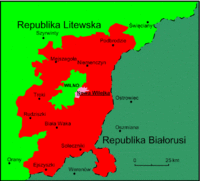Jan Ciechanowicz
Jan Ciechanowicz (Lithuanian: Ivanas Tichonovičius, Janas Ciechanowiczius, Janas Ciechanovičius; Russian: Иван Станиславович Тихонович; born 2 July 1946 in Worniany) is a politician of the Polish minority in Lithuania. He was one of the couple of ethnic Polish deputies of the Supreme Soviet of the USSR (1989–1991).
Biography
Jan Ciechanowicz was born in the former Wilno region, then Belarusian SSR. He studied at the Pedagogical Institute of Foreign Languages in Minsk (1964–1970). He proceeded to earn a doctor's degree. He then worked as a teacher of German and English in Polish schools in the Lithuanian SSR.
In 1975 he became a docent at the University of Vilnius, later becoming the dean of the faculty of Polish at the Vilnius Pedagogical University (1988–1989). In 1988, Ciechanowicz was one of the founders of the Association of Poles in Lithuania. In 1989, he was elected to the Supreme Soviet of the USSR. Ciechanowicz represented pro-Soviet positions,[1] supporting the continuation of the USSR. He was one of the supporters of the autonomy movement of the Poles of the Vilnius/Wilno region, that had been part of Poland before being attached to Lithuania in 1939.

The autonomous Polski Kraj Narodowo-Terytorialny (Polish National-Territorial Region) was established on 6 September 1990 in areas, where Poles formed the majority. The Lithuanian government declared the formation of a Polish autonomous district in Lithuania unconstitutional. At that time, the formation of a Republic of East Poland (Republika Wschodniej Polski) was also seriously discussed, with tacit support from Moscow. After the August Coup of the Soviet hardliners had failed, the Lithuanian authorities suspended the local councils that had sought autonomy or secession from Lithuania.
In 1994, Jan Ciechanowicz moved to Poland, where he has taught German and English at institutions of higher education.